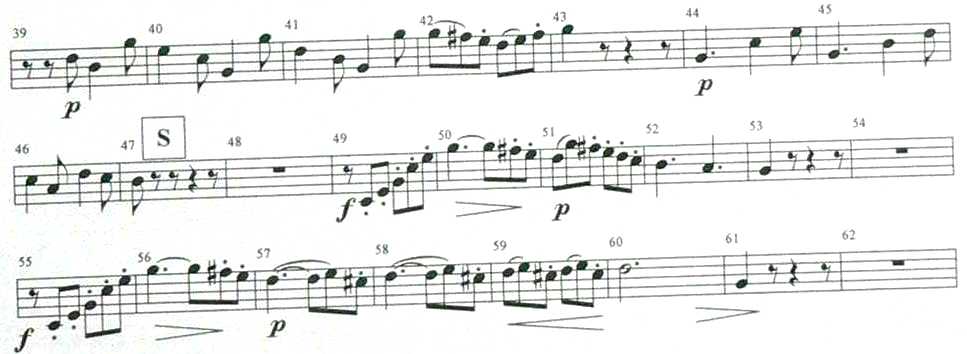|
3eme Concerto pour le Cor op.106 (K.495) |
Ein Waldhorn Konzert für den Leitgeb |
|
How to play this concert |
Interpretationsanleitung |
|
Mozart´s third Concerto for horn, which we named the No.4. Why ? The No.1 D-major is a fragment only, never finished by Mozart himself. |
Mozarts drittes Hornkonzert, das wir als no.4 bezeichnen. Warum ? No.1 in D-Dur ist ja nur ein Fragment, das Mozart nie fertiggestellt hat. |
|
3rd movement: |
RONDO Allegro vivace p.14 |
|
| |
|
Now comes the first rhythmically tricky point. Care very much to keep the 6/8 rhythm and do not transform it to a rhythm like dotted eighth with succeeding sixteenth, as so often heard. The thumb valve might be of great help if used for the up jump to the f2. There is nothing special to say about MM.43-46 except the care for correct rhythm. M.48 should be begun on T1, but only that note, as the Bb-horn might let it speak clear. Returning to the F-side immediately would result, that the T1 for the upper f2 would be felt as a great help. Do not blare the forte & return to a nice piano in the following MM.50-51. A round up slur c2-f2 would be much appreciated & the succeeding eight notes scale should nicely "jump" down, while the dotted fourths in M.51 were fine "detaché". The next phrase is a mere repetition only, but ending in the threefold repeated three note sequence c2-d2-b-natural1. If you use the F-horn here exclusively, you should take advantage of the beauty of the open d2. Do not push the tempo, as the phrase is shortened in the third measure anyway. The page turn must be performed very quickly or being smart, you had the following measured written on top of this page (if not playing by heart) to avoid the "excitement" of losing the path by a slow page turn. |
Nun kommt der erste Trickpunkt. Achte genau darauf, den 6/8 Charakter zu wahren und verändere ihn nicht zu punktierte Achtel plus Sechzehntel, wie so oft zu hören. Das Daumenventil hilft bestimmt wieder beim Sprung zum f2. Über die Takte 43-46 braucht man nichts extra zu sagen. Takt 48 sollte man mit T1 beginnen, aber nur diesen Ton, da er mit dem B-Horn ganz klar anspricht. Sofortige Rückkehr auf die F-Seite würde bewirken, dass T1 für das obere f2 als grosse Hilfe empfunden würde. Plärre aber nicht im forte und kehre in T.50/51 wieder zum schönen piano zurück. Eine hübsche Aufwärtsbindung c2-f2 wäre fein, um anschliessend die folgenden Achtel-Scala "hinunter zu hüpfen", mit den punktierten Viertel, hübsch voneinander getrennt. Die nächste Phrase ist eigentlich nur eine Wiederholung, endet nur in der dreimaligen Achtelfolge c2-d2-h1. wenn Du hier ausschliesslich das F-Horn nutzt, kannst Du dich der Schönheit des offenen d2 bedienen. Drücke nicht auf das Tempo, da die Phrase rhythmisch sowieso im dritten Takt verkürzt wird. Nun sehr schnell umblättern. Es wäre geschickter, die nächsten Takte (62-75) oben auf der Seite einzutragen (wenn man nicht auswendig spielt) , als durch langsames Umblättern aus der Bahn geworfen zu werden. |
